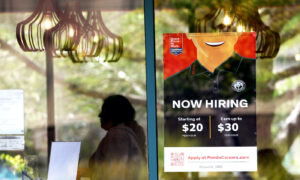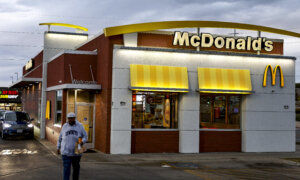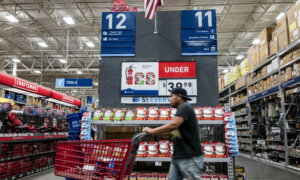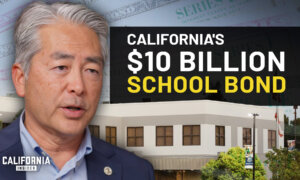A key inflation metric that Federal Reserve Chair Jerome Powell says is “the most important category for understanding the future evolution of core inflation” remains stubbornly high ahead of the U.S. central bank’s likely policy pivot this month.
Supercore inflation—a price measurement of services excluding food, energy, and housing—rose 0.3 percent in August, the largest monthly increase in four months. It was also up 4.5 percent from a year ago, and it has doubled from levels observed before the coronavirus pandemic, according to financial data company Bloomberg Finance’s tracker of CPI supercore inflation.
Though supercore is down from its more than 6 percent peak at the end of 2022, it is not making as much progress as the broader consumer price index (CPI).
Last month, the annual inflation rate eased to 2.5 percent, the lowest level since February 2021.
This is because while core goods inflation has tumbled in 14 of the last 15 months and is up 1.7 percent over the last year, services inflation continues to be a challenge for the U.S. economy.
Services inflation stalled at 4.9 percent in August and has hovered in this range for the past year, according to New York-based data company Trading Economics.
Experts say that a crucial feature of core inflation is that it is less erratic and can function as a window into the future. St. Louis Fed economists previously said it has predicted inflation quite well compared with alternatives.
For the monetary authorities, supercore can better show how labor, the largest expense for businesses, influences inflation trends. Services control the economic landscape, and a significant share of U.S. payrolls is dominated by various industries that serve consumers, such as leisure and hospitality, health care, retail, and finance. As a result, service-sector wages can sizably affect the CPI.
Of course, says Christopher Neely, a St. Louis Fed economist, supercore is one of many inflation gauges.
“[T]here are many measures of inflation that differ in how they weight price changes in categories of goods and services,” he wrote in a blog post in May. “Examining differences between these measures can shed light on some sources of inflationary pressures.”
A gauge outside of supercore indicates that inflation remains elevated.
Sticky and Stubborn Inflation
For instance, the Atlanta Fed’s sticky-price CPI—a metric focusing on consumer goods and services with relatively infrequent price changes—was above 4 percent for 31 consecutive months.A chorus of economists say the task of defeating inflation is unfinished.
Taylor St. Germain, an economist at ITR Economics, pointed to the gradual increase in the U.S. M2 money supply, which has risen 1.5 percent since February. The Fed embarking upon a series of interest rate cuts could also revitalize price pressures.

Sheets of $1 bills run through the printing press at the Bureau of Engraving and Printing in Washington on March 24, 2015. (Mark Wilson/Getty Images)
“We expect inflation will pick up next year alongside a resurgence of macroeconomic activity and likely loosening of monetary policy,” he said. “We may see an uptick in spending on capital goods that could increase pricing pressures, but the effect will likely take time to develop.”
According to economists at Euro Pacific Capital Management, three notable sectors “stand out as red flags” for a potential inflation revival.
The first is medical care, which is “unaffected by the broader market trends,” they said, adding that the “sector’s inflation is often sticky, reflecting structural issues within health care pricing and policy.”
Costs of medical care services slightly changed month over month, but they have risen 3.2 percent from a year ago.
Shelter costs, including rent and owner’s equivalent rent, increased in the August CPI report. The shelter index advanced by 0.5 percent and is up 5.2 percent from the previous 12 months. The subcategories of rent and owners’ equivalent of rent also jumped 0.5 percent from July to August.
“This resurgence is particularly concerning as housing costs constitute a large portion of the CPI basket, directly influencing the headline number,” they said.
Finally, transportation services inflation is another challenge, rising 0.9 percent monthly in August and up 7.9 percent year over year.
“Despite temporary relief in fuel prices, the overall cost of transportation services has not decreased commensurately, indicating underlying inflationary pressures,” the economists said.
According to Brian Coulton, chief economist at Fitch Ratings, the downward trend in the core inflation rate mainly reflected the substantial drop in automobile prices, which, he wrote in a Sept. 10 commentary, might not be a permanent trend.
Ultimately, these various data points might force the Fed to proceed with caution on the adjustment to monetary policy, Coulton said.
‘Still Work to Do on Inflation’
In his keynote address at last month’s Jackson Hole Economic Symposium, Fed Chair Jerome Powell signaled that rate cuts were coming.“The time has come for policy to adjust,” Powell said. “The direction of travel is clear, and the timing and pace of rate cuts will depend on incoming data, the evolving outlook, and the balance of risks.”
Investors overwhelmingly bet the first policy pivot will occur at the September Federal Open Market Committee meeting. The debate in the futures market and among economists is whether the Fed will follow through on a quarter-point or half-point rate cut.
Traders are split, according to the CME FedWatch Tool. The odds of a 25-basis-point reduction are 51 percent, and the probability of a 50-basis-point cut is 49 percent.
Byron Anderson, head of fixed income at Laffer Tengler Investments, noted that bond markets have priced in 10 rate cuts over the next year.
Market watchers will examine the updated Summary of Economic Projections, a guide to the direction of policy and economic data.
Fitch’s Coulton said the Fed is likely to adopt a slow-and-steady approach to loosening monetary policy because “there is still work to be done in reducing services inflation.”
“The long-awaited Fed easing cycle is upon us, but the [Federal Open Market Committee] will be cautious after the inflation challenges of the past few years. The pace of rate cuts will be gentle and monetary easing won’t do much to boost growth next year,” Coulton wrote in a Sept. 10 note to clients.
ING economists disagree, anticipating a more aggressive Fed at the start, with 100 basis points worth of cuts by year’s end.
“We believe the Fed will end up front-loading the easing given deteriorating business surveys and a meaningful slowdown in labor hiring, which in combination will help dampen price pressures more quickly than the Fed is currently assuming,” they wrote in a Sept. 13 note.
Monetary policy officials have warned that easing prematurely could resuscitate inflation.
“History shouts to us that loosening monetary policy prematurely is a dangerous gambit that can rekindle inflation and entrench it in the economy for many months or even years,” wrote Atlanta Fed President Raphael Bostic in a Sept. 4 essay.
Euro Pacific Capital Management economists say that if the Fed’s rate-cutting endeavors fuel inflation, the central bank would have to pivot to tighter monetary policy, “assuming the Fed has the courage to make such a move.”
The Fed’s next two-day policy meeting is scheduled for Sept. 17 and 18.














